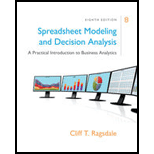
Spreadsheet Modeling & Decision Analysis: A Practical Introduction To Business Analytics, Loose-leaf Version
8th Edition
ISBN: 9781337274852
Author: Ragsdale, Cliff
Publisher: South-Western College Pub
expand_more
expand_more
format_list_bulleted
Textbook Question
Chapter 1, Problem 11QP
Can a model have more than one dependent variable?
Expert Solution & Answer
Want to see the full answer?
Check out a sample textbook solution
Students have asked these similar questions
Question 47 / 60
Root cause is related to:
The "x" on y=f(x)
The "y" on y=f(x)
The "=" on y=f(x)
The "f" on y=f(x)
Question 58/60
Ishikawa is more applicable to projects related to lead
time. This statement is:
True
False
Question 49 / 60
Lean Six Sigma is focused on solving highly complex
problems. This statement is:
False
True
Chapter 1 Solutions
Spreadsheet Modeling & Decision Analysis: A Practical Introduction To Business Analytics, Loose-leaf Version
Ch. 1 - Prob. 1QPCh. 1 - Prob. 2QPCh. 1 - Prob. 3QPCh. 1 - Prob. 4QPCh. 1 - What is the relationship between business...Ch. 1 - What kinds of spreadsheet applications would not...Ch. 1 - Prob. 7QPCh. 1 - Prob. 8QPCh. 1 - What is a dependent variable?Ch. 1 - What is an independent variable?
Ch. 1 - Can a model have more than one dependent variable?Ch. 1 - Can a decision problem have more than one...Ch. 1 - Prob. 13QPCh. 1 - Prob. 14QPCh. 1 - In what ways are descriptive models different from...Ch. 1 - Prob. 16QPCh. 1 - Prob. 17QPCh. 1 - Consider the spreadsheet model shown in Figure...Ch. 1 - Prob. 19QPCh. 1 - Prob. 20QPCh. 1 - Prob. 21QPCh. 1 - Prob. 22QPCh. 1 - Prob. 23QPCh. 1 - Prob. 24QPCh. 1 - Prob. 25QPCh. 1 - Prob. 26QPCh. 1 - Prob. 27QP
Knowledge Booster
Learn more about
Need a deep-dive on the concept behind this application? Look no further. Learn more about this topic, management and related others by exploring similar questions and additional content below.Similar questions
- Question 60 / 60 Lean Six Sigma guarantees that all problems can be solved. This statement is: False Truearrow_forwardQuestion 23/60 Sigma Level is is used to evaluate how stable my process is. This statement is: True Falsearrow_forwardQuestion 24/60 Lean Six Sigma is focused on problems that present low complexity. This statement is: False Truearrow_forward
- Question 19/60 Control Charts are used to evaluate process stability. This statement is: False Truearrow_forwardQuestion 18/60 We must find the root cause in a Lean Six Sigma project. This statement is: False Truearrow_forwardQuestion 17/60 Without data you cannot validate root causes. This True False statement is:arrow_forward
- Question 16/60 Two of the Measurement System Analysis dimensions discussed in this training are Repeatability and Reproducibility. This statement is: True Falsearrow_forwardAverage is important and always sufficient in a baseline analysis of the process. This statement is: False Truearrow_forwardWhat is the main objective of "Measure" phase? Maintain the positive results Present a good problem statement Measure the size of the problemarrow_forward
- Root cause analysis is the core element of Lean Six Sigma projects. This statement is: True Falsearrow_forwardIn the Measure phase of a DMAIC project, variability must be considered in diagnosing the current state of the process. This statement is: True Falsearrow_forwardTo run a final process improvement validation we should consider three dimensions, stability, capability and significance. This statement is: True Falsearrow_forward
arrow_back_ios
SEE MORE QUESTIONS
arrow_forward_ios
Recommended textbooks for you

Forecasting 2: Forecasting Types & Qualitative methods; Author: Adapala Academy & IES GS for Exams;https://www.youtube.com/watch?v=npWni9K6Z_g;License: Standard YouTube License, CC-BY
Introduction to Forecasting - with Examples; Author: Dr. Bharatendra Rai;https://www.youtube.com/watch?v=98K7AG32qv8;License: Standard Youtube License